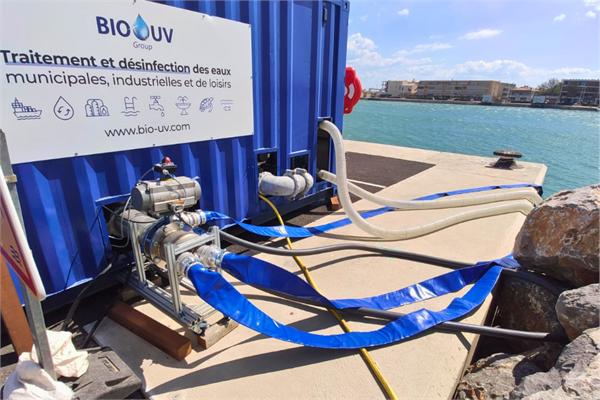
BIO-UV Group has developed a containerised ballast water treatment system designed for the floating offshore wind sector, which is growing fast globally. The system tackles the challenge of preventing the spread of invasive marine species as floating platforms move between territorial waters.
BIO-UV Group, a specialist in UV-based water treatment technologies, has successfully developed and trialled a containerised ballast water treatment system, initially tailored for the floating offshore wind sector.
With floating offshore wind projects expanding rapidly worldwide, compliance with ballast water regulations has emerged as a key challenge. The movement of floating platforms across territorial waters requires measures to prevent the spread of invasive marine species.
“While the maritime industry has made significant strides in ballast water compliance, the floating offshore wind sector is just beginning to recognise its obligations under the Ballast Water Management Convention. Our system offers a portable, scalable solution that meets these needs effectively,” has stated Charlene Ceresola, Project Manager at BIO-UV Group.
The initiative, supported in 2024 through the European Union’s ELBE EUROCLUSTER programme, adapted BIO-UV’s type-approved BIO-SEA technology for deployment within a standard TEU container. This allows operators to treat ballast water on-site during wind turbine assembly, transport, and maintenance. Initial trials centred on a 300m³/h capacity containerised BIO-SEA B02-0340 unit installed at the Euroports-operated Port-la-Nouvelle in France.
Unlike onboard systems, the containerised version requires separate treatment of filter backwash water, discharged at the port and converted into manageable waste for land-based disposal. Real-world testing assessed the prototype’s performance in terms of connection compatibility, pressure drops, and power supply constraints. Results confirmed the system’s ability to deliver BIO-SEA’s approved dual-stage treatment – filtration followed by UV exposure – while ensuring compliance with regulatory standards.
Although biological trials were limited by external factors such as sampling constraints and variable water conditions, early results were encouraging, with discharge water consistently meeting the D-2 standard. Phase One of the project, from January to June 2024, focused on engineering and system testing, while Phase Two, running from July to December, broadened the scope to include market analysis and stakeholder engagement, laying the foundations for future development.
“The modularity and portability of this solution make it ideal not only for offshore wind projects but also for emergency use by ships facing ballast water management system failures. We can now provide ports and harbours with a practical, scalable solution that enables more industries to manage water responsibly. This project underscores our commitment to innovation and sustainability, paving the way for a cleaner, more resilient future,” has added Ceresola.
The units could also be leased or purchased for deployment on barges or within ports, helping vessels with inoperable ballast water systems maintain compliance during unexpected breakdowns. This would provide ports and shipping operators with an effective contingency solution.
For the offshore wind industry, BIO-UV Group has already launched the first commercial containerised unit this year under a ‘ballast as a service’ rental model, offering treatment capacity wherever required. The success of the ELBE project has already generated interest from Mediterranean ports, including those engaged in the EU’s Treasure programme – a series of research and development initiatives aimed at enhancing harbour water management and environmental efficiency.